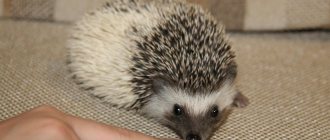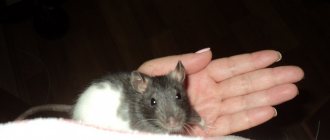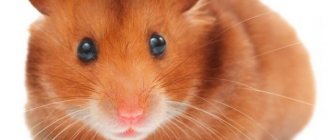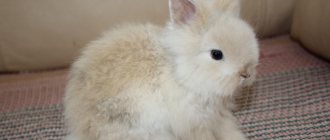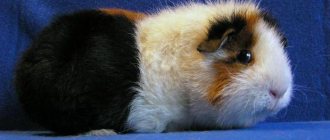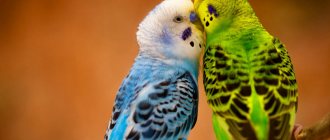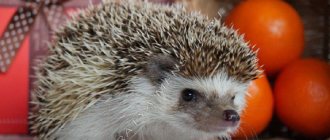The house mouse, or decorative mouse, is increasingly becoming the object of attention of people who are hesitant to buy a dog or cat. These are absolutely unpretentious animals with good adaptive qualities. They quickly become attached to their owners and never show aggression.
However, caring for pet mice has its own nuances. Therefore, before getting such a pet, it is recommended to learn more about the types, nature and features of caring for these rodents.
Description of house mice
Decorative mice are the closest relatives of ordinary house mice. Unlike their wild relatives, they are not afraid of people and therefore are easily tamed.
Appearance
Ornamental mice are small rodents with an elongated pointed muzzle, large round ears and bulging, bead-like eyes.
Their body size is 6.5-9.5 cm in length. The animal weighs 15-30 g. At the back it has a long tail, covered with scales and very sparse thin hairs.
The spine of house mice consists of 5 sections. There are 13 in the thoracic spine, 6 in the lumbar spine, and 7 in the sacral spine. The number of caudal vertebrae can reach up to 20.
Interesting. The number of cervical vertebrae in decorative mice is the same as in a giraffe - 7 pieces.
The narrow chest is formed by 13 pairs of ribs. Females have 5 pairs of nipples on their bellies. Mice have 4 fingers on their forelimbs and 5 on their hind limbs. They are equipped with thin, sharp claws. The front legs are slightly shorter than the hind legs.
Another feature of domestic mice is the absence of pubic fusion of the pelvic bones. Thanks to this, domestic mice can freely and painlessly give birth to fairly large cubs.
The mouse has 16 teeth: 3 chewing teeth on the upper and lower jaws on each side and 4 incisors. The growth of the latter does not stop throughout life, so they need to be ground down.
Breeds of domestic mice
Thanks to breeding work, several types of ornamental mice have appeared. They differ from each other in the length and structure of their coat:
- Short-haired domestic rodents have a dense and smooth coat with a natural glossy sheen.
- Satin mice have hollow hairs that reflect light well, giving their fur a metallic sheen.
- Rex mice have curly fur.
- Abyssinian (rosette) rodents have long or short fur, on which spiral-shaped vortices of hair are formed. According to the standard, these decorative mice must have at least two sockets - one on the left and one on the right side of the body.
- The Angora breed is distinguished by long and smooth silky fur.
- The Texel is a long-haired variety with a curly coat. Curls should be evenly distributed throughout the body. Domestic Texel mice should have curly whiskers.
- Hairless are hairless rodents with folded skin. The mustache may be short, curly or completely absent.
- Downy, or fuzz - these domestic mice resemble rexes, but their coat is softer and velvety with small curls.
Shorthaired mouse
Decorative texel mouse
Hairless decorative mouse
Colors
Decorative mice are available in a wide variety of colors. The most popular are:
- Plain - white, black, chocolate, blue, silver, cream, fawn. Those with white fur may have ruby, black or pink eyes.
- Ticked - when each hair has dark and light areas. Common colors are agouti (blue and grey), chinchilla, pearl, cinnamon, tan, silver.
- Marked or marked is a color that combines areas of coat of different colors. These include - belted, brindle, Dutch, uniform, brocken, spotted, marbled, motley, white rump and others.
- Combined. This group includes shaded and point colors - Himalayan, smoky, Burmese, Siamese, sable and others.
Character and habits of domestic mice
Although decorative mice are nocturnal creatures, at home they often adapt to the biorhythms of their owners. Under artificial light, these rodents can stay awake most of the day, unlike hamsters. Children can pick up a pet without fear - aggression is not typical for decorative mice.
Regardless of whether the mouse is a domestic or wild animal, these rodents can live in groups. They quickly adapt to new conditions and are easily tamed. At home, both different-sex individuals and several females are kept together.
Nimble and mobile decorative rodents are constantly fussing, running, stocking up. House mice are able to interact with each other, unlike hamsters. There are no conflicts between rodents living in the same cage.
These decorative rodents can make interesting sounds. Their squeak resembles a squeak. Sometimes mice chirp like crickets and rustle when they are awake.
Health and life expectancy of ornamental mice
In the wild, mice live no more than 18 months. They die due to attacks by natural enemies, unstable climatic conditions and diseases. Domestic mice are protected from many negative factors, so they live longer - 2.5-3 years.
With proper care, house mice rarely get sick. The state of health may worsen due to low or high humidity in the room, draft, as well as dietary errors.
Elderly individuals often develop tumor processes. Young people have problems with teeth, kidneys, and skin diseases. Cases of eye inflammation are common.
An attentive owner should handle and inspect the pet mouse daily. The following symptoms indicate a deterioration in health:
- hair loss, wounds or ulcers on the skin;
- tearfulness, nasal discharge;
- tousled, unkempt fur;
- apathy, lethargy, lack of physical activity;
- refusal of food;
- bloody discharge under the tail.
Attention! If signs of disease are detected, it is necessary to show the pet mouse to a rodentologist. You cannot postpone a visit to the clinic - diseases in ornamental rodents develop rapidly.
Harm
Damage from mice House mice, with their huge numbers, spoil grain fields.
They don’t so much gnaw grain as they dig tunnels and form embankments. The stem falls to the ground, the grain is damaged, and difficulties arise during harvesting. The main harm caused by a house pest is damage to food supplies and animal feed. Pests contaminate them with feces, urine, and leave behind many bacteria and pathogens.
Undoubted harm is caused to furniture, decorative items, books, and clothing. They chew wood, plastic, rubber, and electrical wiring. For these reasons, primitive man tamed the cat, which successfully destroys rodents.
House mice are carriers of dangerous diseases:
- intestinal infections;
- plague;
- pseudotuberculosis;
- fever;
- rabies;
- tularemia;
- leptospirosis.
Recently, scientists have announced the possibility of transmission of breast cancer by mice. Diseases are spread through feces, urine, saliva, ectoparasites, and bites. A person is simply obliged to combat pests on the territory of his own home.
Interesting facts about mice
The following facts demonstrate how amazing house mice are:
- Contrary to popular belief, these decorative rodents love sweets and lard, not cheese, but eating such food is harmful.
- The mouse genome is almost 80% identical to the human genome.
- Each mouse family has its own unique smell, thanks to which rodents determine their own membership in a particular group.
- House mice have very good hearing, but poor eyesight. They perceive sounds with frequencies up to 100 kHz.
- In a stressful situation, the mouse secretes a substance with a pungent odor along with its urine. It warns relatives of danger. When other rodents sense it, they become afraid and run away.
Which mousetrap is better? How They Work: An Overview of Trap Types
Behind a large number of designs and manufacturers, there are only four types of mouse traps, and we will now analyze them.
Ordinary mousetraps. The simplest type of trap that is familiar to us from childhood or from cartoons. The cheapest option is a classic wooden mousetrap with an iron bracket. The bait is pinned onto the “fishing rod”, and the mouse comes to it. As soon as she tries to take the food with her, the staple will slam shut and pin her down.
The mechanism is quite strong and can kill an animal or injure a person who handles it carelessly
In addition to wooden ones, they now produce plastic and metal traps for rats, which in appearance may differ significantly from the classic model, but retain the same principle.
“Live” traps. This trap does not kill the rodent, but only keeps it in a small enclosure. Suitable for those for whom killing an animal, even a pest, is unacceptable. A caught mouse is simply released away from the house. In addition, this way you can show it to children and teach them humanism by your own example.
Glue traps for mice. They effectively solve the question: how to catch a mouse without a mousetrap. They are boards, trays or slats with glue. They are effective at holding a mouse, although they are unlikely to hold a rat for long. Their disadvantage is action. A mouse caught in the glue, trying to get out, begins to twitch violently and squeak, creating noise. The glue is non-poisonous and will not kill the rodent, but if a mouse gets into the trap at night, you will have to get up and do something about it, because it will be difficult to fall asleep while listening to the squeaking.
Electronic mouse traps. The most effective trap was invented relatively recently. The advantages of an electronic device are obvious: a mouse or rat runs into a trap in search of food and receives an electric shock, dying quickly and painlessly. Perfectly solves the problem: how to catch a mouse in the house without blood and chaos. In addition, electronic traps are convenient and practical for large premises and food warehouses, as they can be used for a long time without recharging.
| Mousetrap type | Advantages | Flaws |
| Common mousetrap | very cheap | doesn't kill quickly |
| “Live” trap (live trap) | cheap and don't kill | you need to take it away and release the mouse |
| Glue trap | cheap | the mouse may squeak and scurry around for several days |
| Electronic trap | kill quickly with an electric discharge, without blood or dirt, the charge is enough for a hundred electric shocks | dears, do not use outdoors without special protection from water |
Is it worth getting a decorative mouse at home?
A live house mouse costs 200-300 rubles. The low price is one of the reasons why many decide to get such a pet. But before you do this, it’s worth learning about all the advantages and disadvantages of keeping a decorative rodent at home.
| pros | Minuses |
| The mouse does not take up much space, does not run around the apartment, and does not damage the owner’s property | The noises made by mice at night disturb the sleep of household members |
| Decorative rodent is undemanding to living conditions | Specific smell |
| Mice are omnivores | Low intelligence of a rodent |
| Small expenses for food and maintenance | Short lifespan |
| The decorative mouse is easy to tame and does not bite. | |
| A pet gives a lot of positive emotions |
Tama the Cat: Train Station Master
This happened in the early 2000s, when the unprofitable Kishi station in the Japanese city of Kinokawa was almost closed due to unprofitability. Residents, of course, protested, but it is unlikely that their efforts would ultimately be crowned with success. The situation was saved by a local cat named Tama, who loved to bask in the sun near the train station. The station manager noticed how enthusiastically passengers reacted to this couch potato and gave him the official position of caretaker. The cat was given a uniform cap, a badge and a monthly salary in the form of free food.
The duties of the newly minted minister included advertising functions. He greeted passengers, allowed himself to be petted, and was always somewhere on the platform. It must be said that this policy very quickly led to commercial success. Tourists began to come to Kishi station just to look at the railway cat and take pictures with him. From that moment on, there was no further talk about closing the station.
But the unusual cat's career did not end there. In 2008, Tama became a supervisor and was charged with monitoring the performance of professional duties by staff. That same year, the cat was knighted. Another year later, according to the project of the famous designer Eiji Mituku, the railway included in the schedule a train dedicated to the legendary animal. The carriages were painted with views of Tama, the locomotive was decorated with his muzzle, and meowing signaled the opening (closing) of the doors. But this did not become the crown of the cat’s career.
A year later, Tamu was appointed third party of the railway company, entrusted with the post of executive director. By his old age, it was already difficult for him to work every day, and the management allowed the elderly cat to come to work 3 days a week.
Tama died at the ripe old age of 14. But even after this, the career did not end. Posthumously, the cat was elevated to the rank of Eternal Station Master, thus perpetuating his memory. After all, over the years of work, this four-legged employee has brought considerable income to his company. The tourist flow through the station increased to 300 thousand people annually, and the financial indicator amounted to more than 1.1 billion Japanese yen.
The company's management did not want to accept the loss of such a profitable and already promoted advertising brand. Tama was replaced by Nitama (the second Tama). True, later with the third cat there was an overlay. He was found at Okayama Station and offered a position in Kishi. But the owner did not agree to the move. Next came Yontama (the fourth Tama), who had already had to undergo a special training course before taking her place on the platform of the railway station.
And the flow of tourists wanting to take a photo with the legendary heirs of the first Tama still does not dry out.
I like2I don't like
Care and maintenance of domestic mice
There is nothing difficult about caring for and maintaining decorative mice, even for a child. The conditions of detention should be as follows:
- indoor air temperature – +20…+27 degrees;
- humidity – 55-65%;
- dim lighting;
- no draft.
Attention! It is important to choose the right place for a house mouse to live. The cage should not be located near heating devices or in direct sunlight. Overheating is dangerous for the life of a rodent.
Cage and filler
Before buying a cage, you need to decide how many mice will live there. For a family of 3-4 individuals, a dwelling measuring 60x50 cm is suitable. The height can be any, but not less than 40 cm. For one house mouse, a cage with dimensions of 40x30 cm is used.
Preference is given to designs made of metal gratings with a plastic removable tray. It’s good if it has high sides, then the filler won’t spill out. The door must close securely, otherwise the decorative mice will escape.
A thick layer of wood shavings is poured onto the bottom - at least 3-4 cm. Only natural materials can be used as bedding - pressed sawdust, crushed corn cobs. Cotton wool, rags, paper are not the best option, as they do not hold back unpleasant odors and quickly get wet.
Interior design of a mouse's home
It is recommended that pet mice have a resting house. You can make it yourself from scrap materials or buy it ready-made at a pet store. A little filler is poured inside so that mice can burrow into it when they are cold or scared.
In addition to the house, you will need a feeder and water bowl, as well as a running wheel to increase physical activity. It is better to give preference to a solid structure without holes. The tail can get stuck there while running, which can lead to injury. If there is enough space in the cage, it is worth placing pipes, tunnels and ladders inside. With their help, it is convenient to connect the first level with the second.
Hygiene
Cleaning the cage of a decorative rodent is done as the litter becomes dirty. If there is only one house mouse living there, the procedure is carried out once every 5-7 days, if there are several, more often. The old filler is thrown away and new filler is added. Every time during cleaning, all equipment is washed - drinking bowl, feeder, pipes and wheel. It is better to clean the tray with a soda solution and scald it with boiling water.
Attention! An unpleasant smell in the cage appears only because the owner of a pet rodent rarely cleans the cage. This is also why mouse fur stinks.
The fur of a house mouse also needs to be looked after. It becomes contaminated with feces and urine, and pieces of food stick to it. Even if the fur smells bad and looks untidy, the decorative rodent should not be bathed. Mice cannot swim and are very afraid of water, unlike domestic rats. Dirty fur can be cleaned in other ways - with a toothbrush, a damp cotton pad or a piece of soft cloth.
Bathing a house mouse in water is allowed in exceptional cases when the contamination cannot be removed in any other way or is life-threatening. To wash your pet you will need a deep bowl. No more than 2 cm of water is taken into it. The fur is gently wetted by hand, then detergent for rodents is applied, lathered and rinsed. After thorough rinsing, the pet mouse is wrapped in a towel and held in your arms for as long as possible so that it does not catch a cold.
Taming of ornamental rodents
A house mouse is easier to tame than a hamster. The main thing in this matter is consistency and regularity of communication.
After purchasing the decorative rodent, leave it alone for a day or two. During this time, he will adapt, inspect and sniff his new home. Next, you can begin to gradually tame the mouse:
- You should approach the cage more often and talk to the rodent in a quiet and gentle voice.
- The next stage is getting used to the owner’s smell. To do this, you need to feed the mouse by hand through the grill.
- After a few days, you can try to open the door and give something tasty in the palm of your hand. The rodent will have to come and take the food on its own.
- Soon the house mouse will understand that the owner's hands do not pose a threat. She will begin to climb right into your palm and eat calmly. At such moments, you need to carefully stroke her back.
- At the final stage of taming, the decorative mouse will calmly allow you to pull yourself together. The main thing is not to scare her with sudden movements or loud noise.
To prevent a house mouse from going wild, you need to regularly communicate with it. If you don't pick it up for a long time, it will quickly wean itself off its owner.
Important! House mice love company. If an ornamental rodent lives alone in a cage, it needs to be given more attention.
Rules for Effective Communication
To consolidate taming and effective communication with the pet, you need to allow the mouse to gradually get used to the owner. It is recommended to pick up your pet rodent several times a day, spending at least half an hour playing.
To begin to accustom a mouse to a nickname, at the first stage it is necessary to cover the cage with thick fabric - thanks to this, the owner’s voice will become the only source of information for the animal. After this, say the name of the mouse several times, and then remove the cloth and pamper your pet with a treat. After a couple of days, repeat the learning process in daylight.
The nickname for the mouse should be short, no more than 2 syllables and contain the consonant sounds s, n, m, k, ts, ch, sh, shch.
Ornamental mice can be fun pets that are fun to watch. They are quite easy to tame, but they need to be constantly looked after. The cleaning and feeding processes are not too complicated, but they can keep the owner’s house clean and provide the animals with a long, rich life.
Tips for choosing the right cage for decorative mice and its contents. Proper organization of nutrition for domestic rodents in the video:
Features of feeding
House mice are undemanding when it comes to nutrition. Their diet is based on dry grains and seeds. Pet stores sell ready-made mixtures with a rich composition for pet rodents. These include:
- millet;
- barley;
- wheat;
- corn;
- peas;
- buckwheat;
- sunflower seeds;
- nuts.
Domestic mice also enjoy eating fruits and vegetables - carrots, cabbage, cucumbers, zucchini, apples and pears. Twice a week you can give rodents low-fat cottage cheese, boiled chicken breast, eggs, dried fruits and cereals. In the summer, fresh greens are introduced into the diet of domestic mice - leaves of nettle, dandelion, plantain.
Prohibited products:
- Red beetroot;
- sweets;
- bread;
- conservation;
- snacks, salty foods;
- sausage, frankfurters;
- fatty food;
- mushrooms.
To wear down their teeth, domestic mice are given twigs of fruit trees or shrubs to chew on. To compensate for the deficiency of minerals, a salt lick stone is placed in the cage. The drinking bowl should always be filled with clean water.
Specific substrate needs
Provide a deep layer of aspen shavings or some other suitable substrate in the cage.
Avoid cedar and pine chips due to the strong volatile oils released from these woods (especially cedar). You can also use strips of cloth, a soft paper towel, or hay. Mice will tear it up and build nests from it. Small cardboard boxes work well, although they will become shredded over time and will often need replacing. You can also use clay flower pots with holes cut into them or placed on the sides, as can pieces of PVC pipe that you can find at a hardware store. Clean your mouse's enclosure every month or two (frequent changes can be harmful).
Breeding
House mice become sexually mature at 30-35 days of age. In females, estrus begins; in males, a sign of maturation is the descent of the testes into the scrotum. It is recommended that females be mated for the first time upon reaching three months of age.
Effective mating is possible only during estrus, which occurs in females every 3-8 days and lasts from 4 to 20 hours. Pregnancy in house mice lasts 22 days.
Approximately in the middle of gestation, the female begins to build a house or nest from the litter in which the pups will be located after birth. She uses wood shavings, scraps of soft fabric, paper, and napkins as building materials. It is important to ensure that all this is at the disposal of the pregnant female.
There are from 5 to 9 mice in a litter. They are born naked, blind and deaf. The weight of a newborn mouse is 1-2 g.
Little mice develop quickly. On the third day they develop hearing, and on the fourth day their bodies are covered with soft fur. By the fifth day of life, their body weight doubles. Two weeks after birth, the eyes open. From this age, domestic mice begin to feed themselves. The young animals are weaned from their mother on the 21st-25th day.
To avoid uncontrolled reproduction, male domestic mice are separated from females.
Many people are not sure whether to get a pet mouse, because this animal has already earned a bad reputation. However, ornamental species of rodents make excellent pets - they are easy to care for, interesting to watch, mice are quickly tamed, and do not require much attention or high maintenance costs.
Taming
If you want to tame your pet, start at a very early age, but not too often. However, this must be done very carefully, otherwise the small mouse may get injured.
When a friendship begins, the pet will spend time on the shoulders, in the arms, and also, he will recognize the owner. Some owners talk about the mouse's ability to remember its name and respond to it.
Note!
- How to protect a gazebo from rain and wind in summer and snow in winter - a review of the best options
Chicken - description, types, classification, nutrition and maintenance of domestic chicken (115 photos and videos)
Fretka - lifestyle, care and character traits. 115 photos and videos tips for keeping a pet ferret
Dental system
Rodents have well-developed incisors: two pairs on each jaw. The front teeth have no roots and grow throughout the mouse's short life. To prevent excessive growth, mice must constantly grind them down. The upper incisors are much larger than the lower ones, and are covered with durable enamel on the front.
Pests do not have fangs; instead, the jaw has a toothless edge - a diastema, behind which there is a palisade of molars. With their help, food is ground and crushed. The surface of some teeth is smooth, while others are covered with tubercles. Like incisors, molars are constantly growing and need to be ground down. Tree branches are perfect for these purposes.
When trying to gnaw on something metal or hard, the lower incisors may break, which leads to an incorrect bite: the teeth of the upper jaw bend inward, the animal is unable to close its mouth, cannot eat, and as a result dies from starvation.
Sense organs (eyes, ears and teeth)
The bat's eyesight is poor, but its ears can detect the slightest rustle several meters away. The auricle is huge.
Before flying, pushing off from the surface, the animal emits a piercing squeak, which, when it encounters an obstacle, returns. This echolocation allows one to navigate at night and serves as a technique for catching prey.
Eyes of medium size. Set on the front of the muzzle. Vision is black and white. When sunlight appears or imitates it, the bird experiences pain.
The jaw consists of incisors, molars, premolars, and canines. The pungency, shape and quantity depend on the nutrition of the chiropteran creature:
- in insectivores - 38, long, shaped like mortars;
- bloodsuckers have 20–26 teeth, sharp, large on a well-developed jaw.

